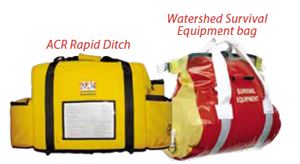Photos by Frank Lanier

Any suggested references or sources that I might check for an abandon-ship checklist? Its not the most pleasant of topics, and I know it will vary from boat to boat, but I would like any information on the basics that should be on any such list. We appreciate any help you might provide.
Chuck and Judy Rushing
Anabel, 2003 Catalina 36 MkII
Solomons, Md.
As you noted, what supplies are included in a ditch kit will vary, depending on where you sail and what type of sailing youre doing. We recommend that all cruisers carry an abandon-ship bag, even coastal cruisers, and that those who daysail in open water seriously consider a scaled-down version. The kits contents will also depend on whether the ditch bag will be your sole source for emergency gear in an adandon-ship situation, or whether it will supplement a pre-packaged emergency kit packed with the life raft.
Companies like LRSE (Life Raft and Survival Equipment) allow you to create your own pre-packaged ditch kit online. These are a great option, but you can also put together your own abandon-ship kit at home. To get an idea of what you should include, browse the itemized lists of the pre-packaged kits on the market and see what seasoned bluewater voyagers recommend. The Landfall Navigation website has a pretty thorough starter list for grab-bag contents; youll find it here: www.landfallnavigation.com/abandoncheck.html.
Also, books like Beth Leonards The Voyagers Handbook and The Grab Bag Book by Frances and Michael Howorth (PS, January 2013) can be great resources for such things. Leonard lists the basic contents for the minimal, moderate, and all-out ditch kit, while the Howorths shopping lists are much more in-depth. The Howorths book includes a comprehensive shopping list and lists of variations for different climates and sailing areas.
We also recommend reading Steve Callahans Adrift: Seventy-six Days Lost at Sea to get a good idea of just what youll need to survive in a life raft long-term. Callahan wrote the gripping book after surviving for two and a half months aboard his life raft, alone. With todays sophisticated signaling devices-EPIRBs, PLBs, SARTs, SENDs, etc-fewer abandon-ship victims spend that much time awaiting rescue, but its best to be prepared for the worst. Nothing is foolproof at sea.
In PSs May 2007 issue, we reviewed the survival equipment that life-raft makers pack in their rafts. That article includes a rundown of gear that testers deem necessary to have on hand in case of an abandon-ship emergency. Check it out for some basic guidance.
The most basic abandon-ship gear includes signaling devices (flares, EPIRB, VHF, signal mirror, etc.), food and water/watermaker (plus can opener and small fishing tackle), shelter and sun protection (tarp, nylon cord, hats, clothes), medications and first-aid kit, and personal gear (spare eyeglasses, knife, TP, can opener, waterproof flashlights with batteries, navigation tools, and copies of your passport and other important papers, cash, etc.). If you can afford one, a 406-MHz EPIRB is extremely important to have; if you can’t, look into renting one for long passages and crossings. At the very least, your ditch kit should include a waterproof, handheld VHF and batteries for communication with rescuers.
Be sure to choose a well-made, buoyant, waterproof bag to store it all in. Brands like ACR (PS, October 2006), Landfall Navigation, Watershed Survival Equipment (PS, December 2012), and LRSE sell bags designed to be ditch bags.
Be thorough but selective when putting together your abandon-ship kit. Youll want to pack everything and the kitchen sink, but remember that youll still need to heft it off the boat, so don’t overpack.









































